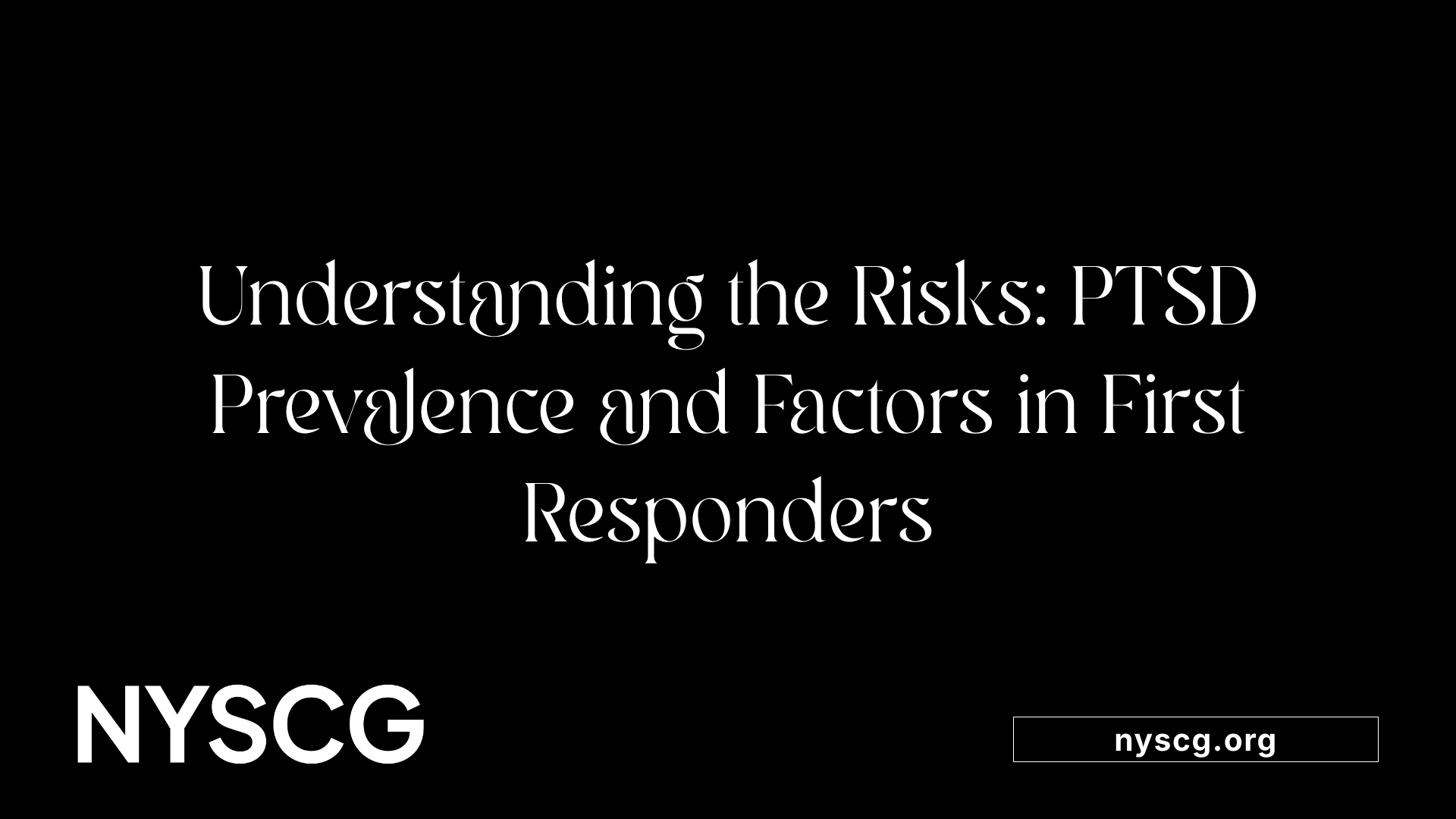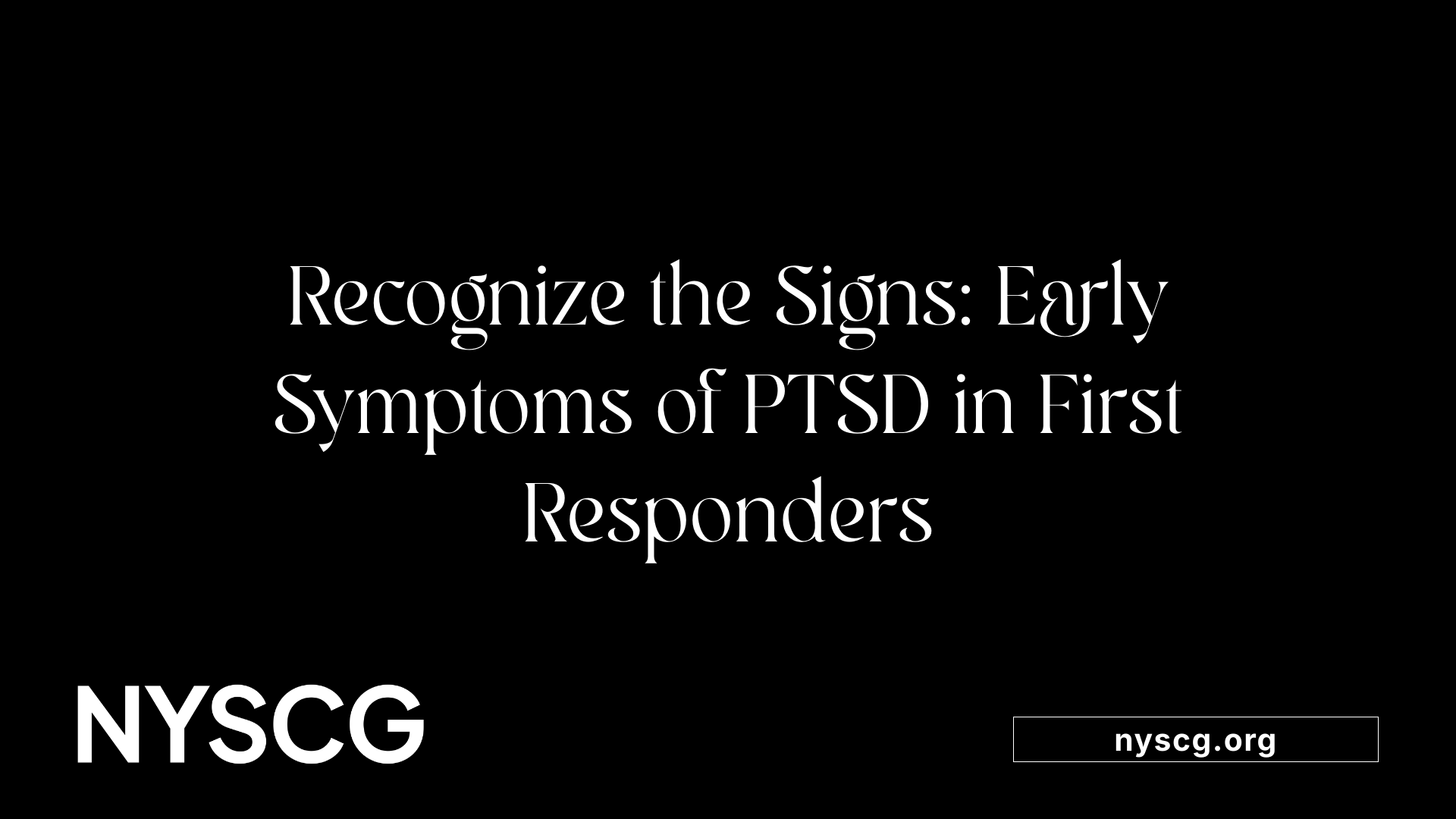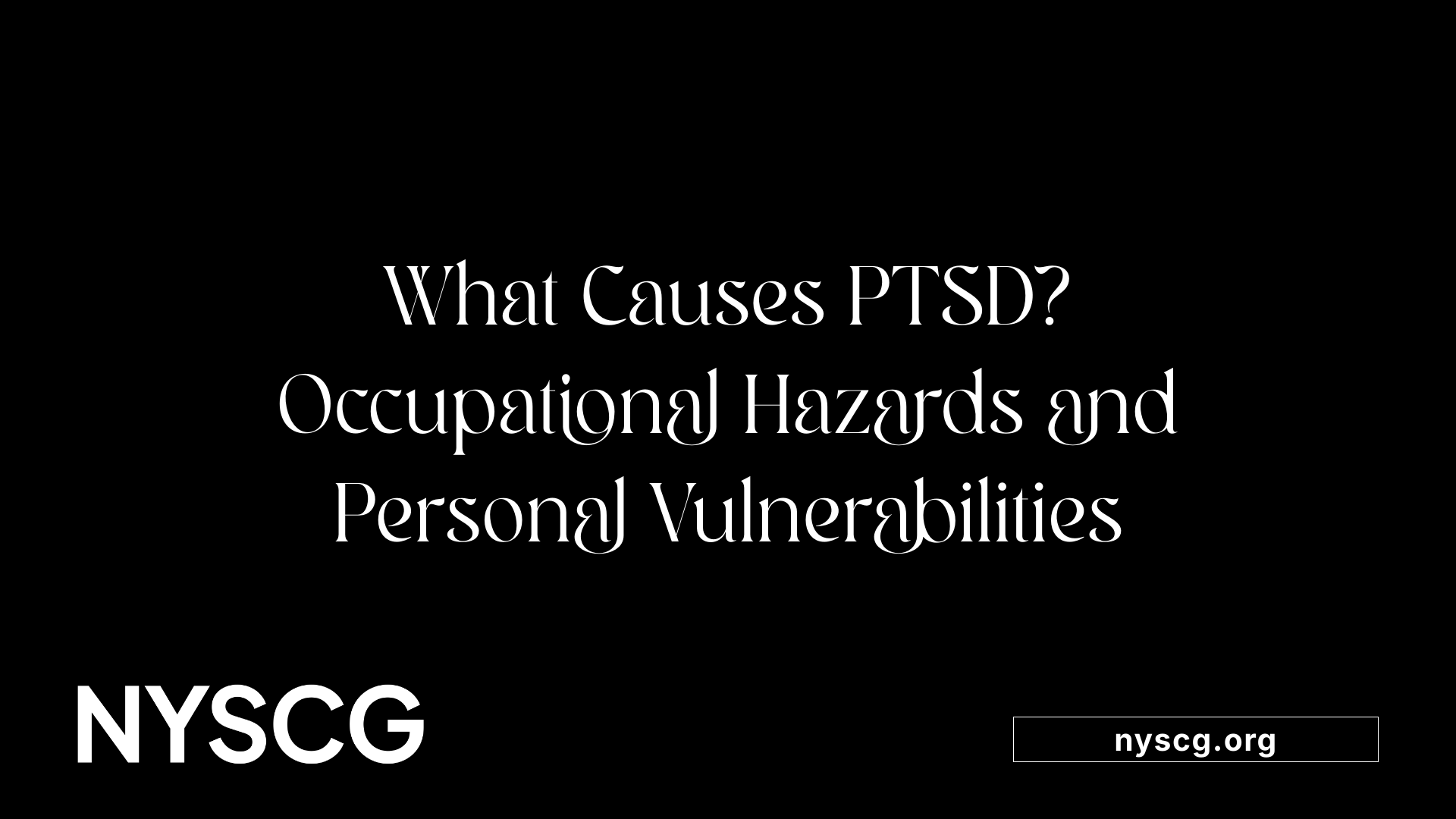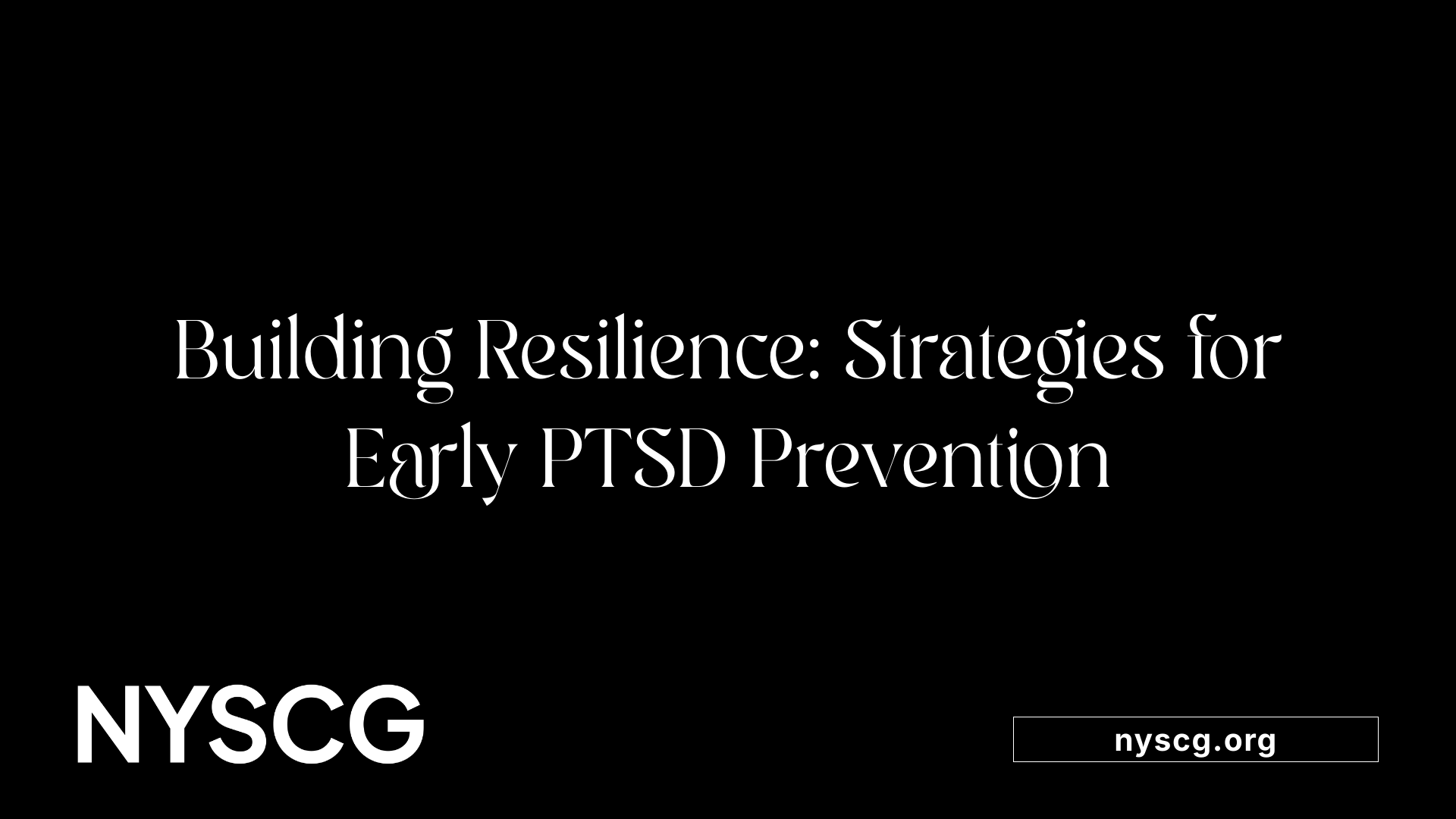Helping First Responders Process PTSD Symptoms


First responders such as firefighters, police officers, and paramedics are crucial to community safety, often working in high-stress environments that expose them to traumatic events regularly. The nature of their work, involving witnessing injuries, violence, and disaster scenes, makes them particularly vulnerable to developing post-traumatic stress disorder (PTSD). Recognizing how PTSD manifests, its prevalence among first responders, and effective strategies for processing symptoms are essential to fostering their mental health and resilience. This article explores comprehensive approaches, including evidence-based treatments, innovative telehealth options, organizational support, and resources tailored to help first responders process and heal from PTSD.

PTSD is a significant concern within the first responder community, affecting a sizable portion of those exposed to traumatic incidents in their roles. Studies reveal wide-ranging prevalence rates: roughly 1.9% to 57% among firefighters, with a more consistent estimate around 17% to 32%. Police officers exhibit PTSD rates from 6% to 32%, and paramedics see about 9% to 22%. These figures underscore the heightened vulnerability of these groups, especially given their frequent exposure to trauma.
In total, approximately one in three first responders develop PTSD during their careers. In the United States alone, over 400,000 individuals working in emergency services exhibit symptoms of PTSD, a figure that is growing due to factors such as large-scale disasters, frequent emergency calls, and the ongoing stress of the COVID-19 pandemic. The high prevalence in this occupational group emphasizes the importance of specialized mental health interventions and support systems tailored for first responders.
PTSD in first responders primarily results from their continuous exposure to disturbing and traumatic events. These include accidents, natural disasters, acts of violence, and scenes of severe injury or death. The nature of their work often involves witnessing human suffering, experiencing life-threatening situations, and feeling helpless during emergencies.
Repeated exposure to such traumatic scenes significantly increases the risk of developing PTSD. The stressors are compounded by work conditions like long hours, high levels of alertness, and emotional exhaustion. The constant anticipation of emergencies and the perception of inadequate support can also elevate the risk.
Individual factors further influence susceptibility. A personal history of psychiatric issues, childhood adversity, or lack of social and occupational support can make some first responders more vulnerable. The biological response to trauma, involving the activation of the fight-or-flight system and the release of stress hormones like cortisol, can, over time, cause physical health issues such as high blood pressure, compromised immune function, and metabolic disturbances.
This combination of occupational hazards and individual predispositions results in a higher incidence of PTSD compared to the general population, necessitating targeted prevention and intervention strategies. Recognizing these causes allows organizations to implement proactive measures, such as resilience training, early screening, and access to mental health care, to better support the mental well-being of first responders.

First responders who develop PTSD often experience a range of distressing symptoms that can affect their mental, emotional, and physical health. One of the hallmark features is intrusive memories, which include flashbacks and nightmares that unexpectedly resurface, causing significant distress.
Physically, they may suffer from chronic issues such as headaches, dizziness, sweating, and chest pain. These physical manifestations can be mistaken for other medical conditions but are often linked to the emotional turmoil caused by trauma.
Emotionally, many first responders report feelings of numbness—they may seem detached or emotionally flat, unable to experience joy or connection in their personal lives. Sleep disturbances are common, with difficulties falling asleep, frequent awakenings, or nightmares disrupting restorative sleep.
Avoidance behaviors also mark PTSD in these individuals. They might steer clear of places, people, or activities that remind them of the traumatic events. This social withdrawal can strain relationships and reduce their support networks.
Hyperarousal symptoms include hypervigilance, where individuals constantly feel on edge, and an exaggerated startle response to sudden stimuli. Emotional reactivity is heightened, with outbursts of anger or irritability becoming frequent.
The combination of these symptoms can severely impair daily functioning, hinder recovery, and increase the risk of other mental health issues like anxiety and depression.
PTSD can profoundly diminish the overall mental health and well-being of first responders. The persistent experience of intrusive thoughts and hyperarousal can lead to chronic stress, anxiety, and depression, often compounded by feelings of guilt or shame related to not being able to prevent or control traumatic events.
Substance abuse may develop as a maladaptive coping mechanism, further complicating mental health struggles. The emotional numbing and social withdrawal weaken personal relationships, which are vital for emotional resilience.
Many first responders report more severe dysphoric symptoms, such as intense anger, irritability, and loss of interest in activities they once enjoyed. Sleep disturbances like insomnia or nightmares contribute to fatigue and cognitive impairments, impacting their ability to perform both professionally and personally.
Barriers such as stigma around mental health, fear of job repercussions, and limited access to tailored, confidential care often prevent early treatment. As a result, symptoms can worsen, leading to a cycle of deterioration that affects their overall quality of life.
Addressing these impacts requires organizations to provide supportive, stigma-free environments and access to specialized treatment options — including telehealth services, trauma-focused therapies like EMDR and CBT, and holistic wellness programs. Such measures are crucial for fostering recovery and resilience among first responders.

First responders are frequently exposed to traumatic events, which are the primary cause of PTSD in this occupational group. These include witnessing severe injuries, fatalities, or natural disasters such as fires, accidents, violent crimes, and scenes of destruction. Such experiences often involve high degrees of danger, suffering, and helplessness, creating a fertile ground for trauma to develop.
The demanding nature of their work environment exacerbates this risk. Long hours, unpredictable emergencies, heightened state of alertness, and the pressure to respond quickly and efficiently all contribute to chronic stress. These factors promote a state of hypervigilance and emotional exhaustion, which over time can lead to the development of PTSD.
Witnessing human suffering and experiencing life-threatening situations directly or indirectly can trigger traumatic reactions. The cumulative effect of repeated exposure to such traumatic incidents increases vulnerability to PTSD symptoms like intrusive memories, nightmares, emotional numbness, and avoidance behaviors.
Individual susceptibility also plays a significant role. Personal history factors such as previous mental health issues, childhood adversity, and genetic predispositions can influence the likelihood of developing PTSD. Perceived lack of support, feelings of isolation, and stigma surrounding mental health within first responder communities can further hinder timely intervention.
In summary, the combination of frequent traumatic exposure, challenging work environments, and personal vulnerabilities contributes substantially to PTSD in first responders. Their exposure to violence, accidents, and natural disasters, coupled with occupational stressors like long shifts and constant readiness, accentuates the risk.
Cause CategorySpecific FactorsAdditional DetailsExposure to traumatic eventsWitnessing death, severe injuries, violence, natural disastersHigh frequency of exposure increases cumulative trauma riskWork environment factorsLong hours, high-stress situations, unpredictable emergenciesContributes to chronic stress, emotional exhaustion, hypervigilanceIndividual susceptibilityPrevious psychiatric issues, childhood trauma, lack of supportPersonal history can increase likelihood of PTSD development
Understanding these causes underscores the importance of targeted interventions, timely support, and tailored treatment programs for first responders to mitigate PTSD risk and promote healing.

Reducing the risk of PTSD in first responders involves a multi-layered approach that focuses on resilience building, organizational support, and early intervention. Resilience training programs are integral, teaching stress management, emotional regulation, and coping skills tailored specifically to first responders’ experiences.
Organizational policies play a significant role in fostering a supportive work environment. These policies should promote open communication about mental health, reduce stigma, and encourage seeking help without fear of job repercussions. Implementing body- and movement-oriented interventions (BMOI), such as mindfulness exercises, relaxation techniques, yoga, and physical activity, can bolster resilience by improving physiological stress responses.
Regular mental health assessments using validated tools like the Cognitive Processing Therapy (CPT) or PTSD Checklist (PCL-5) allow for early detection of symptoms. Integrating evidence-based treatments such as cognitive-behavioral therapy (CBT), exposure therapy, and EMDR into routine care facilitates prompt intervention.
To overcome barriers like cost, transportation, and stigma, confidential telehealth options have been developed, ensuring accessible mental health support tailored for first responders. Cultivating a workplace culture that normalizes mental health care, along with educational campaigns, further contributes to prevention.
Finally, preparedness training that includes psychological skills, crisis debriefings, and peer support programs strengthen the first responders’ capacity to manage traumatic exposure proactively.
Early recognition of PTSD among first responders hinges on awareness of specific symptoms and the use of systematic screening processes. Traumatic exposure often leads to symptoms like intrusive memories, nightmares, hypervigilance, avoidance behaviors, mood disturbances, and physical signs such as irritability or sleep problems.
Routine screening with standardized tools like the PTSD Checklist for DSM-5 (PCL-5) or the Clinician-Administered PTSD Scale (CAPS-5) is essential. These measures help identify emerging symptoms shortly after trauma or during regular health checks.
It's important to foster an environment where first responders feel comfortable discussing their mental health. Education about normal reactions to trauma and the importance of early help can motivate individuals to seek support.
Colleagues and supervisors should be trained to observe signs of distress, such as withdrawal from team activities, irritability, or difficulty concentrating. Early signs may include emotional numbness, exaggerated startle responses, or physical symptoms like headaches.
Encouraging open dialogue and providing access to confidential mental health services enable faster intervention. Recognizing that symptoms like persistent avoidance, sleep disturbances, or increased substance use beyond normal coping suggest the need for professional assessment.
Early intervention, ideally within weeks of trauma exposure, can prevent the progression to chronic PTSD. Support from peers, family, and mental health professionals is crucial in creating a safety net for early detection and treatment.
First responders facing PTSD have access to a variety of effective treatment options that address their unique needs. Evidence-based therapies such as cognitive-behavioral therapy (CBT), including specialized forms like Cognitive Processing Therapy (CPT) and Prolonged Exposure (PE), are commonly used and supported by strong clinical research. These therapies help individuals process traumatic memories, modify negative thought patterns, and reduce avoidance behaviors.
Another highly effective modality is Eye Movement Desensitization and Reprocessing (EMDR), which focuses on reprocessing traumatic memories through guided eye movements or other rhythmic stimuli. EMDR is particularly beneficial for symptom reduction and trauma integration.
Medication can also be part of a comprehensive treatment plan. Antidepressants such as sertraline and paroxetine are often prescribed to manage symptoms like anxiety, depression, and intrusive thoughts. When combined with psychotherapy, medication can improve overall functioning and resilience.
A biopsychosocial approach, utilizing an interdisciplinary team of mental health professionals, aims to address biological, psychological, and social factors contributing to PTSD. Telehealth services are increasingly used to deliver these treatments remotely, overcoming logistical barriers and enhancing confidentiality.
Tailoring treatment to individual circumstances is crucial. Clinicians consider barriers like stigma, costs, work schedules, and accessibility, often incorporating ongoing assessments to monitor progress and adapt interventions accordingly. Early intervention and sustained support greatly enhance recovery chances, helping first responders regain control over their lives.
Yes, first responders have access to a broad spectrum of resources designed to support their mental health and recovery. Many organizations provide specialized, trauma-informed services, including counseling and peer support programs. The First Responders Foundation, ResponderStrong, and Deer Hollow are notable agencies that offer evidence-based therapies like CBT and EMDR, along with holistic approaches such as mindfulness, yoga, and relaxation techniques.
Community-based programs play a vital role. For example, the Missouri Department of Mental Health's First Responder Provider Network offers targeted assessments, educational seminars, and crisis interventions tailored explicitly for emergency personnel.
Crisis helplines and online platforms also provide immediate access to confidential support. The 988 Suicide and Crisis Lifeline, Safe Call Now, and the National Suicide Prevention Lifeline offer 24/7 assistance for individuals experiencing distress.
Local peer support groups are crucial in creating a sense of community, where first responders can share experiences, reduce stigma, and foster resilience. Intensive outpatient programs (IOPs) and specialty clinics like the IAFF Center of Excellence or Desert Parkway Behavioral Healthcare provide structured care addressing both PTSD and co-occurring substance use.
Interacting with individuals with PTSD requires sensitivity and understanding. Avoid making dismissive or minimizing comments such as "Just get over it" or "It’s not that bad," as these can invalidate their feelings and exacerbate shame or guilt.
It is important to steer clear of startling them with loud noises or surprises, which can trigger flashbacks or panic. Respect their boundaries, and do not press for details they are uncomfortable sharing.
Refrain from invading their personal space or making intrusive comments about their trauma. Empathy and patience are essential; do not push them to discuss traumatic events if they’re not ready.
Supporting someone with PTSD means fostering a safe environment by avoiding triggers and maintaining a non-judgmental attitude. Overall, promoting trust and respecting their pace in healing are crucial in supporting their recovery.
Telehealth, especially through clinical video teleconferencing (CVT), has become an essential tool in delivering mental health support to first responders dealing with PTSD. This approach offers several advantages, including increased accessibility, flexibility, and cultural sensitivity — crucial factors given the demanding schedules and often remote locations of first responders.
Research demonstrates that evidence-based treatments like cognitive processing therapy (CPT) and prolonged exposure (PE) can be effectively administered via telehealth. Outcomes from these remote treatments have been shown to be comparable to traditional in-office therapy, with the added benefits of maintaining treatment fidelity and boosting patient engagement. This is particularly critical for responders in rural or underserved communities who might otherwise face barriers to in-person mental health care.
By overcoming geographical barriers, telehealth allows first responders to receive timely intervention without the need to travel, which can be difficult due to work constraints or transport issues. Furthermore, virtual therapies help in addressing stigma associated with seeking mental health support, as individuals can access help from the privacy of their homes or usual work environments.
Safety considerations in telehealth are vital. Therapists conduct comprehensive risk assessments and establish secure, confidential environments to ensure patient privacy and safety, especially when dealing with crises or suicidal ideation. Secure platforms with encryption and strict privacy protocols are used to prevent breaches and protect sensitive information.
Overall, telehealth significantly enhances the ability of first responders to access effective mental health treatments promptly, fostering resilience and recovery. It allows for a flexible, private, and efficient delivery of services that aligns with the unique needs of first responders, making it a cornerstone of innovative mental health support.
Early recognition of PTSD in first responders hinges on awareness of its common signs and symptoms. These include intrusive memories, nightmares, hyperarousal (such as heightened alertness and difficulty sleeping), avoidance of trauma-related stimuli, mood swings, and physical symptoms like irritability and fatigue.
Regular screening using standardized tools like the PTSD Checklist (PCL-5) or the Clinician-Administered PTSD Scale (CAPS-5) can help identify symptoms soon after traumatic events. These assessments are crucial in uncovering PTSD early, especially since some symptoms might be subtle or mistaken for general stress.
Encouraging a supportive environment where first responders feel safe discussing their mental health is essential. Psychoeducation about PTSD helps individuals understand their reactions and alleviates stigma, encouraging early help-seeking.
Prompt intervention with trauma-focused psychotherapy, such as cognitive-behavioral therapy (CBT), eye movement desensitization and reprocessing (EMDR), or medication, can prevent the progression to chronic PTSD. Early treatment reduces symptom severity and improves functional outcomes.
Family, colleagues, and supervisors play a pivotal role in early recognition. They can assist by observing behavioral changes and supporting affected individuals to seek professional help. Promoting resilience through stress management techniques and peer support networks further facilitates early intervention.
In doing so, the risk of developing long-lasting mental health issues diminishes, enabling first responders to maintain their wellbeing and continue their vital roles in the community.

PTSD can profoundly affect first responders’ mental health, leading to a cascade of emotional and physical challenges. Many experience increased levels of depression, anxiety, and substance abuse as they struggle to cope with trauma. The emotional numbness and social withdrawal that often accompany PTSD can damage personal relationships and reduce social support networks.
Additionally, symptoms such as heightened anger, irritability, irritable sleep patterns, and concentration difficulties make functioning in daily life challenging. These issues are often compounded by barriers to treatment—such as stigma, fear of job repercussions, or limited access to mental health services—delaying or preventing recovery.
Without proper intervention, PTSD can diminish overall quality of life, impair work effectiveness, and elevate suicide risk. Recognizing these impacts highlights the importance of tailored, accessible therapies, including innovative options like biometric telehealth, to address and mitigate these adverse effects.
Resilience is vital for helping first responders bounce back from traumatic experiences and sustain mental health. Engaging in holistic health practices fosters emotional stability and physical health. Activities like regular exercise, maintaining a balanced diet, ensuring sufficient sleep, and practicing mindfulness techniques such as yoga and meditation can significantly reduce stress levels.
Peer support programs and community networks provide more than just shared experiences—they create a sense of belonging and understanding that can combat feelings of isolation. These groups enable first responders to share coping strategies and gain emotional support from colleagues who understand their unique challenges.
Fostering a supportive work environment is equally crucial. Leadership initiatives—such as regular debriefings, mental health awareness training, and encouraging open conversations about trauma—can break down stigma. When organizations normalize seeking help and prioritize mental health, they cultivate resilience on both individual and collective levels.
These approaches work synergistically to enhance adaptability, emotional regulation, and overall well-being. As first responders build resilience, they are better equipped to manage stress, recover from trauma, and maintain a healthy psychological state throughout their demanding careers.
AspectApproachBenefitAdditional DetailsPhysical health & mindfulnessExercise, diet, sleep, yoga, meditationReduces stress, improves mood, enhances sleep qualityPromotes overall wellness and emotional regulationCommunity & peer supportSupport groups, shared experiencesDecreases isolation, increases sense of belongingFacilitates coping, reduces stigmaSupportive work environmentLeadership training, mental health initiativesNormalizes mental health care, encourages help-seekingBuilds organizational resilience and reduces burnout
Understanding how resilience and community enhance recovery can guide organizations and individuals in creating comprehensive strategies that promote mental well-being. These efforts not only help in managing PTSD symptoms but also empower first responders to thrive despite occupational challenges.
Addressing PTSD among first responders requires a comprehensive approach that combines early recognition, trauma-informed treatment, innovative therapies such as telehealth, and supportive organizational policies. Building resilience through community support, psychoeducation, and holistic health practices is vital. Ensuring access to tailored resources and reducing stigma are crucial steps to encourage help-seeking behaviors. As awareness about the unique mental health challenges faced by first responders grows, so does the commitment to their healing and well-being. Supporting these everyday heroes not only benefits their personal health but also enhances their ability to serve and protect the communities they bravely safeguard. A collective effort toward understanding and processing PTSD can lead to a resilient, healthier future for first responders.
All you need is the will to make the world a better place.
New York State chaplain group inc. is a tax deductible organization with a federal tax Id number 92-383-4921